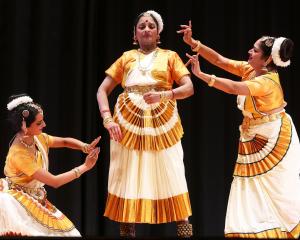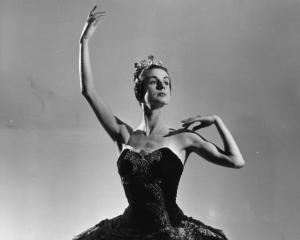
Ballet stager Thierry Guiderdoni still remembers the feelings of responsibility and pressure when he took the stage in one of the main roles in William Forsythe's Artifact II.
Just as Royal New Zealand Ballet artistic director Patricia Barker does for George Balanchine's Serenade.
''It's one of the first ballets I danced as a professional dancer. I danced in the ensemble, then I danced 'dark angel' then on to 'Russian girl' then on to 'Waltz girl'.''
The pair are now staging the works for the Royal New Zealand Ballet's (RNZB) season ''Bold Moves'', a bill of works which includes New Zealand choreographer Andrea Schermoly's Stand to Reason and the Flames of Paris pas de deux.
As stagers, Guiderdoni and Barker teach the dancers the choreography of the works and ensure the steps, style and placement are all in accordance with the original choreographer's intentions.

''It's my job to share as much as I can and beyond with the dancers. I'm doing what I love so it doesn't feel like a job.''
He remembers dancing both couple roles in Artifact II and the feeling of the responsibility of getting it right.
''I remember big pressure because the duos are really, really complex and because the boundaries are really pushed to the extreme you feel very responsible to your partner.''
It is his third trip to work with the RNZB (the first was in 2016) which is an advantage, he says.
''I know most of the dancers and how they work, you know the spirit of the company. For certain dancers you know their qualities and where to trigger them, where to push to get a faster result and even go further - the choices are endless.''
Artifact II - the second act of full-length ballet Artifact, created in 1984 - focuses on two couples with the rest of the company taking a less important role.

It requires a lot of the couples who are on stage for the full piece, he says. They need to build an emotional relationship, allowing them to communicate without words.
''They need sensitivity and openness. It's non-stop.
''It's almost like ballroom dancing ... but here the involvement of the two genders are really important. You are partnering the woman but you are involved in the pas de deux 50:50, I'd say. ''
On top of that is the strict way of learning Forsythe choreography and the challenges of a piece where a curtain drops down abruptly and briefly five times.
''It is one act but seven scenes. It is constructed differently, they are endless. You don't know when it has started or when it is finished, abstractly of course.''
Guiderdoni has discovered his five weeks of teaching requires three phases of learning, from the first where only the steps are taught, to the second locking in the qualities required for the dancers and adding their personality and skills, tailoring it to each individual.
''It is very exciting for them because they are doing something they don't know. It puts them in places they [are] not used to. It forces them to explore their own physicalities and how powerful they can be without being restricted to the normal rules they have in ballet technique.''
The third phase is when he steps back, allowing the dancer's own musicality to come forward as they make the work their own.
''I've learnt through the years that it is important to have the ballet ready a week early so they can find their own feet.
''I'm slowly fading away and letting them grow to the last level, to free up and feel the steps.''

Serenade, a ''non-story'' ballet which premiered 85 years ago in the United States, is considered an ''iconic'' ballet which is a rite of passage for any ballet company.
It is a ballet Barker knows very well, as she has danced every female role in the work.
''Each and every time, I continue to understand the complexity of simplicity. When you know each and every role within the ballet, you understand the layers of onions it takes to put on the work, you understand the cannons and the climax of the music and of the steps.
''It's a work where you actually see the music on stage within the movement of the dancers and the ballet has history here. I love to revert back to our history.''
RNZB first performed it in 1975 under artistic director Una Kai. So Barker follows in her footsteps.
''The idea that it is part of my DNA and part of the DNA of the company means it is a great marriage.''
Barker has been following Andrea Schermoly's work since before she moved to New Zealand. One of her first commissions for RNZB was Stand to Reason for last year's ''Strength and Grace'' programme which was only performed in Wellington.
''I've watched her career take off. I feel very proud as someone who helped this incredible artist to continue her work.''
The work was very popular during its Wellington season and during its Festival of Colour in Wanaka performance.
''It's a piece that is important for the rest of the country to see. It shows the depth of talent and the spirit of New Zealand because it is done here at home.''
Flames of Paris is a piece that has been performed during ''Tutus on Tour'' and it was very popular with the audiences. Barker has also danced the piece in galas.
''It's wonderful to bring a bravura [showstopper] piece to the programme.
''I wanted the rest of the nation to see our dancers explode on stage like that. It's just plain fun.''
The dancers have also had great joy in the studio taking on the challenges of the piece, she says.
''It's been great to watch that.''
Artefact II is another ballet Barker has danced and partnered with Guiderdoni in one production.
''I love watching the work, I love dancing the work.''
''It's breathtaking and it leaves me breathless when I hear the music and I see the dancers move. When the curtain comes down for the last time I want it to go back up again. I want to continue watching.''
To see
Royal New Zealand Ballet Bold Moves, Regent Theatre, September 11, 7.30pm.










